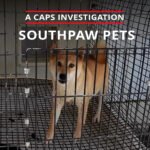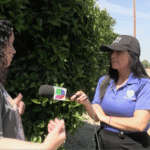Breeder: Pease, Dan, Hattie & Kim
Business name: Rockin P Kennel
Address: 8100 S 590 Rd
City, State Zip: Miami, OK 74354
Year: 2007
USDA License: 73-B-1780
Date of CAPS Investigation: 2007-02-26
Breeds: Shih Tzu, Chihuahuas, Dachshunds, Miniature Poodles
On the premises at the time of investigation: approximately 110 dogs, and an undetermined number of puppies.
Pease’s kennel consisted of a whelping building and several rows of outdoor breeder pens.
Whelping building
The whelping building was a trailer with indoor/outdoor whelping and breeder cages made of plastic and treated wire. These cages were arranged in two layers along each of two sides of the trailer. Most of the cages housed a whelping mother and puppies, while the others housed pairs of breeders. The cages had metal dog doors connecting the indoor and outdoor pens, were elevated over plastic sheeting installed to catch feces and debris, and had water dishes and automatic feeders in the indoor pens. There were about 40 cages in this building.
Poodle cage
The entrance to the building opened to a storage room containing kennel food, supplies, and veterinary medicine. While the owner did not allow access into this room, it was evident there was a single miniature Poodle in an elevated, treated-wire cage that measured about 2.5 feet in width, height, and length. The Poodle was nearly two feet long from the tip of the nose to the base of the tail and had thick mats covering her body (3.6(c)(1)(i)-Primary enclosures; (2.40-Vet care).
This dog’s head was constantly tilted to the left, a condition that Pease said she didn’t understand but hoped would go away on its own after the Poodle was placed with other dogs (2.40-Vet care).
A raised water dish was attached to a wire wall, and a metal food dish was placed on the wire flooring in a manner that did not minimize contamination by excreta (3.9(b)-Feeding).
There was several days’ accumulation of feces on newspaper covering a plastic sheet under the flooring (3.11(a)-Cleaning of primary enclosures).
On top of the Poodle’s cage were two empty, stacked cages. The middle cage had several days’ accumulation of feces on newspaper covering a plastic sheet under its wire flooring (3.11(a)-Cleaning of primary enclosures).
Outdoor pens
The outdoor pens were arranged in four rows next to each other with about eight pens per row. Each pen had wire walls, a layer of rocks covering the ground, and food and water dishes placed on the rocks. Tarps attached to the walls served as windbreaks, and metal roofs covered each row of pens.
The food dishes were not placed so as to minimize contamination by excreta or pests (3.9(b)-Feeding).
Each pen contained one plastic dog house and housed two to four small-breed dogs. The dog houses were about two feet wide, two feet high, and three feet long. In the pens housing Shih Tzus and dogs that were each about a foot long, not all the animals could fit in the dog house at once and lie in a normal manner or turn about freely (3.4(b)-Shelter from the elements).
Dog houses in three Shih Tzu pens were covered in a dirty build-up. Because these pens had a thick layer of rocks on the ground, it is likely the build-up was excrement (3.1(c)(1)(3)-Surfaces).
Many dogs in these pens had matted fur. One pen contained a mixed-breed dog and a Maltese that had small mats covering its coat. Many Shih Tzu, too, were matted, some slightly matted and others with thick tufts of dirty fur on their undersides and around their faces (2.40-Vet care).
Outdoor cages
Two sets of outdoor cages were located next to the outdoor pens described above. Each set had three cages raised above the ground on cinderblocks and wood. These cages had wire walls and treated-wire floorings and had a fully-enclosed wooden box accessed by a dog door at the end of the pen. Water dishes and pieces of carpet were on the treated-wire flooring of these cages. Only two cages were occupied, one with two Dachshunds and another with three Chihuahuas.
The flooring of the Chihuahua pen had feces mashed into the wire in several places (3.11(a)-Cleaning of primary enclosures).




